The cab of the
locomotive is in
pretty sad
shape. Because all the windows had been removed 20
years
ago, the interior has been exposed to the elements. Open
doors to
the cab have let in anyone interested in stealing anything of interest
or potential value. Nearly all the gauges and lamps are
either
missing or smashed. Any wire larger than #14 is
gone. But,
it has the feel of a foreign built locomotive and the potential to once
again look like it did way back in 1964.
Part of
restoration is
documentation of evidence of the artifact's past.
In the
case of the 9010, I decided to do a little "sandpaper
archeology" on
the cab door where there was some stenciling. What
I found
was the
entire history of the locomotive contained in 3 coats of
paint.
First
was a coat of good looking glossy enamel green with the 9010 stencil on
top. Second was a coat of semi-gloss green with the 9113
lettering on
top. Finally, there is a coat of flat green that looks like
it
was
applied with a brush. The 8799 lettering was on this surface.
1964 - 1965 SP 9010 class DF-801 (Diesel Freight)
1965 - 1969 SP 9113 class KF636-1 (Krauss-Maffei Freight, 6 axle, 3600
horsepower)
1969 - now SP 8799 class none on the door (within the SP, it was
class "camera")
Note the weight decrease between the 9010's 358,000# and the 324,300#
of the Camera Car. This decrease resulted from the removal of the front
transmission and all the ancillary equipment from the number one
radiator room
The weight for the 8799 is on top of the 9113 lettering so I documented
that in photo 1 before sanding any further. Photo 2 shows the
"358" of
the 9113 weight but there are no zeros after it.
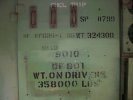 |
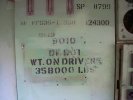 |
--
Update March 12, 2010 --
Dan
Furtado has taken on the task of paint removal and metal cleaning on
the cab surfaces. Initially, he is working on the areas
surrounding the windows so we can paint under where the new molding for
the glass will
go. On most surfaces, he is using commercial paint stripper
followed by a good sanding.
And from guest columnist Bob Zenk:
KM built two retractable windows into the 9010's cab. (They're the
smaller, lower ones next to the rear handrail mounts. ) These windows
are accessed from behind the engineer's and fireman's seats, and it's a
step down to running board level. They raise and lower with a hand
crank, just like a car window. (Younger readers may need to look this
up in Wikipedia!)
SP crew members tell us these windows were sometimes used to catch
train
orders handed up 'on the fly' in bad weather -- the KM cab floor at the
operator's stations was so much higher than normal U.S. locomotives in
order to clear all the spinning bits below, and it could be a long
reach from a cab seat.
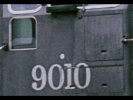
Jack
Whitmeyer Photo
|
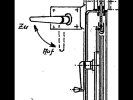
Krauss
Maffei Drawing Detail
|
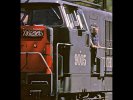
Bob
Morris Photo
|
Both pieces of 9010's glass were broken out at some point, and the
aluminum frames had to be removed to properly prep the body sides for
paint. The crank handles were also long-missing, and there was a
suspicious lack of a gear head and shaft on the engineer's side.
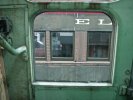
Bob
Zenk Photo
|
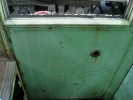
Bob Zenk Photo
|
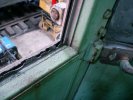
Bob Zenk Photo
|
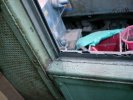
Bob Zenk Photo
|
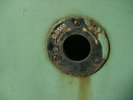
Bob Zenk Photo
|
Removing the inner panels revealed some interesting details of KM
construction, which bear close relationship to German autos of the
period, such as Mercedes or Porsche. There were a couple dozen small
flathead slotted screws holding the frame to the body, and more
flathead slotted screws keeping the rubber 'scraper' molding in place.
All the rubber is rotten, and must be replaced.
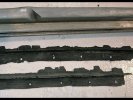
Bob Zenk Photo
|
When we pulled the interior cover panels to expose the window regulator
mechanisms, we found three surprises. One isn't a big surprise, which
is that the window regulator mechanism (der Fensterheber-mechanismus)
was an automotive-style part. The surprise was on the engineer's side,
when we discovered that the window on that side was being held up by a
genuine Sacramento General Shops length of 2x4 softwood!
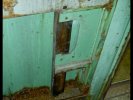
Bob Zenk Photo
|
The other surprise was how heavy the interior panel turned out to be.
The back of the steel panel is covered with at least a quarter-inch
thickness of heavy rubber mastic sheeting. Or maybe not surprising,
considering how much effort KM invested in sound-deadening the cab,
from stone wool in all the air spaces to rubber isolation cones for the
mounting of the cab itself to the frame.
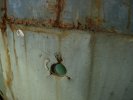
Bob Zenk Photo
|
We're now looking for one replacement regulator mechanism. We
discovered that the regulator from a 1964-vintage Porsche is configured
in a similar manner, but with shorter arms and a smaller geared
quadrant. We figure the KM mechanism is likely from the catalog of a
light-duty German truck, but German vintage truck info is hard to come
by here in the U.S. even with the advantage of good search engines.
With Porsche mechanisms relatively easy to find in the U.S. we may end
up modifying one of those by extending the arms and adding a few more
degrees of teeth to the 'rack'.
When bead-blasted and re-coated with a zinc paint, our one remaining
regulator looks pretty good. It still needs a couple of gnarled gear
teeth repaired, but should be good to go. A build date of 7-63 proves
that this part correctly precedes the locomotives own build date --
important for those 'concours judges' at car shows!
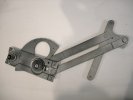
Bob Zenk Photo
|
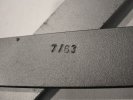
Bob Zenk Photo
|
Removing the snappy KM-signature aluminum trim, we discovered a lot of
dings and dents -- and one huge gash, also on the engineer's side.
Photos seem to show this very gash appearing on 9010 as early as 1965!
But certain kinds of damage, if deliberately uncorrected for the sake
of history, would just look like sloppy restoration. So it
got some straightening out of the
distortion around the whack. We'll decide later if the gouge
is worth
filling, or best left alone, the better to 'tell the story' of our used
locomotive's hard life!
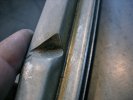
Bob Zenk Photo
|
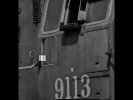
C
P Zander Collection
|
The process of 'dinging out' the aluminum requires a lot of careful
tapping on the back side to "tent the dent", some very judicious file
work, and then some hand block sanding with progressive grades of
automotive sandpaper. A final pass on the buffing wheel with some
aluminum compound brings back the original luster.
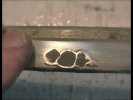
Bob Zenk Photo
|
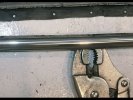
Bob Zenk Photo
|
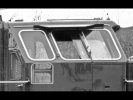
Krauss
Maffei Werkfoto
|
We'll let this naturally weather to a satin aluminum sheen. Nobody
likes 'over-restored' showpieces, but in many areas the KM was built
that way, to automotive standards of detail. They just didn't weather
very well on the SP, without the weekly attention to which German
machines of the period were accustomed. But they sure looked
sharp in 1964, and very 'German'.
--
Update May 25, 2010 --
Photo
#1 illustrates two problems. First is the Prime vent
that
the SP installed during the R7 shopping in late 1966. It does
not
belong in our restoration time frame and was excised.
Luckily, it
was part of a hatch in the cab roof which was easily removed.
Due to the
deformation of the plate to which it was attached, the entire plate was
cut out and replaced.
The
other issue is with the really ugly antenna cable that the SP hung from
the ceiling. The holes needed to be patched and the antenna
cable
will be routed in a less conspicuous manner.
We
elected to remove all of the perforated ceiling panels. They
have
fiberglass cloth glued to the top side and because of various
paintings, the holes are plugged with green paint. They were
stripped and painted and fresh cloth was glued to the top surface.
Dan
continues working on the window cab openings.
Note the hole
in the cab roof where the hatch was removed for rework.
He
also cleaned and painted the interior and exterior surfaces surrounding
the door window openings so we could have new glass installed.
The glass man came a week later and it really looks nice.
I
decided to remove the gauge panel for refurbishing as the SP had
drilled holes to plug unused gauges. The goal is to
return
it to stock appearance so the holes were welded closed and then the
panel was painted. The computer generated gauges give an idea
of
what the panel will someday look like.
--
Update June 13, 2010 --
-- From Bob Zenk --
The
engraved plastic labels for the cab back panel switches and gauges were
in sorry, sorry shape. The SP had removed or blanked many of the
instruments and switches during various phases of 9010's life. They'd
painted over the labels with a brush during the conversion to Camera
Car, and the aluminum frames had suffered a lot of pitting and dents.
Paint
remover was not an option, because the plastic pieces are clear strips,
back-painted black and then engraved from the back, with those engraved
characters then filled in with off-white paint by hand. So any attempt
to remove the green paint with solvent would have destroyed what
remained of the original lettering.
The answer was like so much
of 9010's restoration -- elbow grease and time. First, the plastic
labels had to be separated from the frames, which was a very delicate
operation with a razor blade to keep from cracking the old plastic.
Then a fresh razor blade was used to 'plane' the surface and get rid of
the old paint and any surface scratches. Then came time for the hard
labor -- a tedious series of fine sandpapers meant for plastic
polishing, in grits from 2000 to 12000, followed by fine hand polish
and a coat of wax. Any missing areas of back-painting were recoated
with black, and any missing white in the letters was replaced with a
#000 brush.
The
aluminum pieces required dinging out with a drill rod inserted into the
fold, and light taps of a hammer. Then the pits were addressed with
sandpaper from 220 up to 600, before starting the same procedure with
finer grades. The last pass was a medium paint polish and then a metal
polish.
Here's a before and after of the same area of the same piece.
And as we say in German, viola! The final pieces will go back when the
rest of the cab panels are refinished.
|